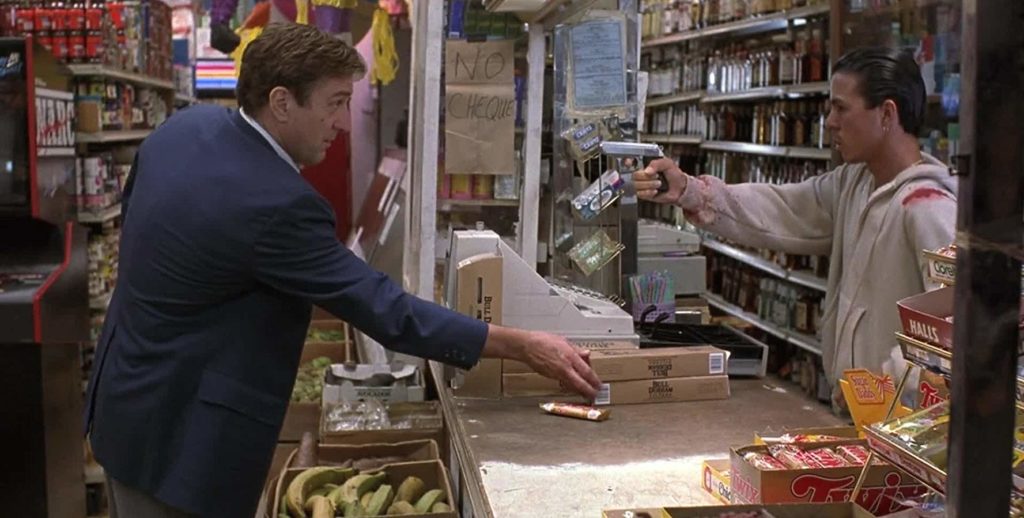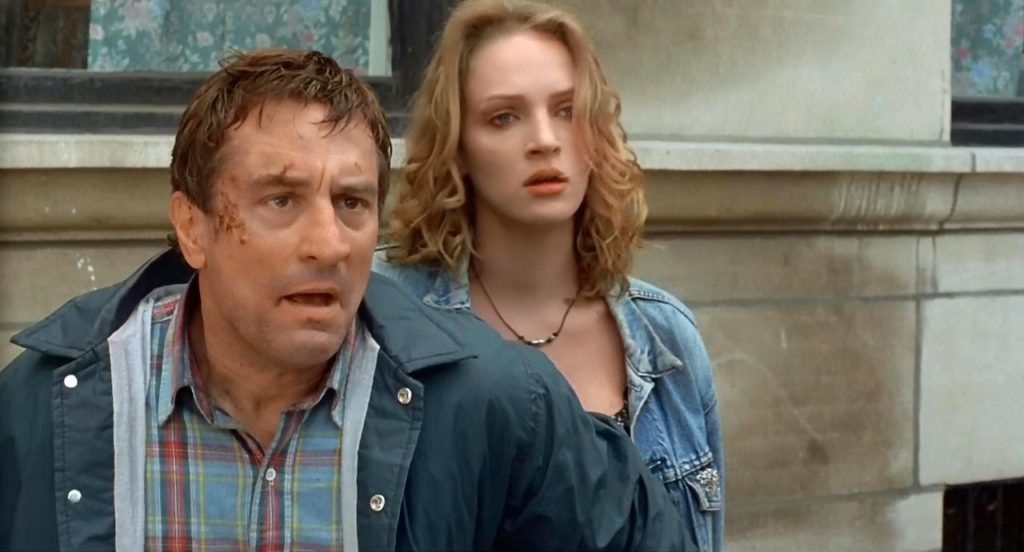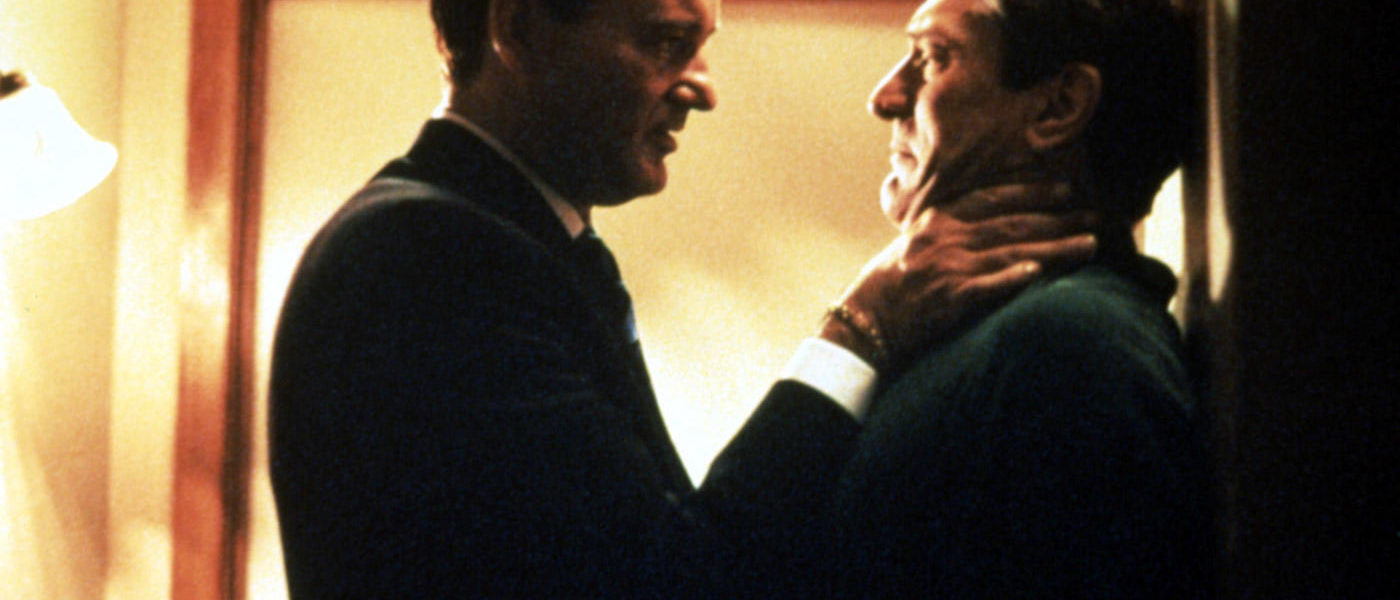Robert De Niro, Bill Murray and Uma Thurman Walk a Compelling in Overlooked Gem.
DIRECTED BY JOHN MCNAUGHTON/1993
BLU-RAY STREET DATE: MARCH 5, 2019/KINO LORBER STUDIO CLASSICS

Robert De Niro. Bill Murray. Uma Thurman. Together in one movie. A good movie. An interesting movie. An odd movie. A surprisingly topical movie. And yet… how is it that no one ever talks about Mad Dog and Glory?
De Niro plays Wayne “Mad Dog” Dobie, a longtime police detective who does his job extremely well and hasn’t had to unholster his gun in fifteen years. When he happens to save the life of Frank Milo (an uncharacteristically scary Bill Murray), a neurotic mafioso type, he’s repaid with a live-in visit from Glory (a young, vibrant Uma Thurman), previously glimpsed working as a bartender at Milo’s comedy club (a place Frank apparently only owns so that he can freely indulge his hobby of doing stand-up).
“No guts, no glory” is a mantra commonly parroted throughout this story. For Wayne, for all intents and purposes, it turns out to be true. Only by unholstering his gun and facing down a man he knows to be dangerous does he achieve the classical arc of the hero getting the girl once he “mans up”. Glory is his literal reward. But whereas this is the end of so many other films, it’s merely the end of Act One in this one.
From that point on, we witness the uneasy emboldening of Wayne, a gradual leaning in towards what we now call “toxic masculinity”. He remains a viable protagonist, on account of he’s still trying to do the right thing- buy Glory her freedom from Milo. But in return… what expectations might Wayne harbor? The plot to free the girl is one thing, but the true interest of the filmmaker lies in how it all affects Wayne. It’s a refreshingly lopsided take on conventional narrative stereotypes, which are being twisted by McNaughton. Yet he refuses to broadcast it as such.

And so… a film unafraid to be about male fragility in layered and even daring ways, Mad Dog and Glory flurries in under the radar in the early portion of the Clinton Years. It was, in fact, a time when the widespread popularization of softening/sensitivity aggressively swang at men like a sledgehammer, seeking to eradicate warmed-over notions of “bootstraps” isolationist manhood that dominated the previous decade (and most of American history). Suddenly, for the less fair sex, there was a shift from rugged handshakes and sports talk to teary hugs and poetry jams. For attuned filmmakers, this sea change proved fertile ground for examining the downfall of traditional masculinity while also questioning on what’s being lost. In retrospect, it’s plain to see that director John McNaughton was at the forefront of a decade-defining topic of interest. (Also see: American Beauty, Fight Club, LA Confidential, and more). It’s an uneasy place, but McNaughton and his cast embrace it fully.
Amid all of the deliberate awkwardness and occasional bloody violence and “authentic manhood” tropes being sullied, there’s a thread of grace sewn throughout this entire film. Nearly every character with any decency bears a major burden for another, often of the physical nature, and always free of cost. From Glory’s recollection of placing herself in the possession of Milo in order to get her brother out of trouble to Wayne’s closest coworker sparing him a beating by readily taking on a mob heavy, all of Mad Dog and Glory is full of such selfless actions. Even the mob heavy, Harold (Mike Starr), displays a little grace in the way he carries out his job as Frank’s righthand man. This applies to Wayne as well, although he’s hobbled by bad moves and dumb responses throughout. He’s far more of a sad sack than a “Mad Dog”, but even at his most provoked, he’s never not relatable.

This is why Robert De Niro, always an urban armadillo of an actor specializing in playing tough exteriors just over soft vulnerability, is the perfect choice to play Wayne. Conventional casting wisdom, particularly that of the day, would flip the two male leads, allowing De Niro to go tough as Frank the mob boss, and mainstream comedic superstar Bill Murray to play a more lovable version of Wayne. Thankfully, McNaughton’s outside-the-box methodology was firmly ensconced in this project even at this early phase.
With its ratty apartments, blah police stations, and cluttered quick shops, Mad Dog and Glory wears its mundane urbanity confidently. It is rare studio film, particularly for its era, that reads as completely non-dressed by an art department. It is, of course. But only the end credits definitively betray that fact. Likewise, this new Blu-ray edition from Kino Lorber Studio Classics boasts an excellent representation of all of the film’s visuals, in all their rugged glory.
Kino Lorber’s new disc of Mad Dog and Glory is an outstanding release of an overlooked accomplishment. McNaughton and a trusty cohort contribute a more recent audio commentary, their memories of the production fresher in some places than others, but that’s entirely understandable. Also included are several very brief vintage interview clips with Uma Thurman, Bill Murray, Robert De Niro, John McNaughton, and producer Martin Scorsese, as well as an old making of featurette.
Mad Dog and Glory stands as a prime anomaly on several fronts. It’s a studio film by an established independent filmmaker (McNaughton was reeled in for this by no less than Martin Scorsese). It’s a gruff cop movie that’s actually a quirky character study mired in grace. It’s a bold Bill Murray film that no one ever mentions. It’s not what anyone expected at the time but has aged extremely well. Cheers to Kino Lorber for letting this glorious dog out again, and in fine form.


